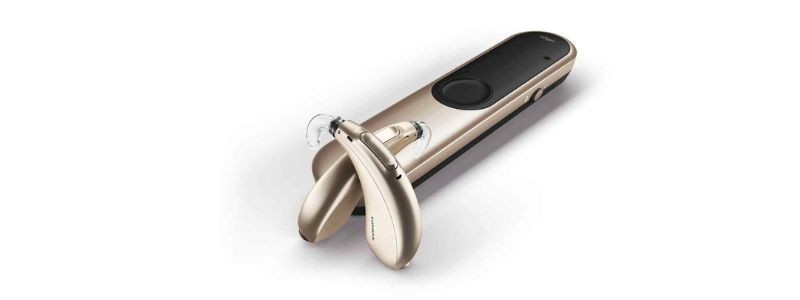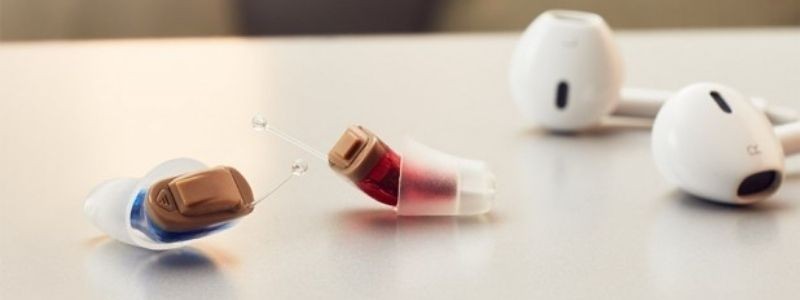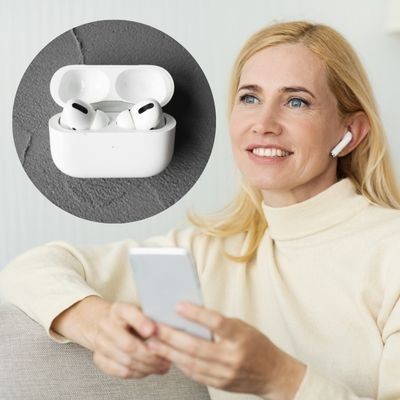
Head of Online Medical Content

Audiology Expert at Hearing Aid UK

Affordable Hearing Aids in the UK
Do cheap and affordable hearing aids that really work exist?
Overview | Affordable vs expensive hearing aids | What to look out for | Advantages and disadvantages | Conclusion | Chat to us about affordable hearing aids
Affordable hearing aids overview
Affordable hearing aids are budget-friendly devices designed to improve hearing for those with mild to moderate hearing loss. They offer essential features such as noise reduction, Bluetooth connectivity, and rechargeable batteries.
Some hearing aid brands now offer "essential" hearing aid ranges, making hearing aids accessible to more people. Affordable hearing aids are usually labelled as 'essential' hearing aids in the audiology industry.
However, this article's purpose is to help you understand hearing aid prices, what you are paying for, and whether you need the top model and performance. We hope it goes some way to make the hearing aid research less stressful and complex.
Discover great, affordable hearing aids without compromising
Hearing loss is a common problem that affects millions of people worldwide. It can have a significant impact on one's quality of life, making communication and social interaction challenging. Hearing aids are a common solution to this problem, but they can also be expensive.
Fortunately, there are affordable hearing aids available that can help people with hearing loss without breaking the bank. In this article, we will discuss affordable hearing aids and how they can help people with hearing loss.
Cheap hearing aids vs expensive hearing aids
You might be asking yourself whether you need the top hearing aids and looking for 'cheap' hearing aids or an affordable hearing aid centre near you. Once you’ve embarked on finding the right hearing aids for you, it can suddenly start to feel like navigating a maze of industry options.
Brands, shapes, models, styles, price – it is quite a challenge especially when you are researching for the first time or you are a new wearer.
Cheap hearing aids, affordable hearing aids - What's the difference?
Are cheap hearing aids good? We know that everyone's perception and idea of 'cheap' and 'affordable' is different, so it is important to understand that we are generalising here. When people refer to cheap hearing aids, this would mainly be the OTC hearing aids you've probably already seen online.
These aren't hearing aids, but sound amplifiers. We talk about over-the-counter (OTC) hearing aids in this article here, which you might find useful and will educate you on the difference between this product and digital hearing aids.
Are affordable hearing aids an industry trade-off?
Over the years, digital hearing aids have become better, more innovative, and more advanced. In the past, there were limited choices, which made decisions easier, but in reality, the devices didn’t work very well. Now there has been a trade-off.
Easier decision-making that offers poor results is replaced with more choice, but great technology that provides hearing solutions that work. That ultimately brings its own complexities, as you try to make sense of the industry and what's on offer as a consumer.
However, even though researching the hearing solutions available on the market today can be intimidating, it really doesn't have to be. You can now access great information online that can give you a better education on hearing loss and hearing aid solutions.
Your hearing care professional can support you, along with your family, helping you overcome the challenges and get your hearing back on track.

Balance your priorities and find a good local audiologist
The most important first step is finding the right local audiologist who will support you in your decision-making, test your hearing, and provide the best hearing aid aftercare for you and your hearing loss. Aftercare that is just as unique as you.
Your audiologist will recommend hearing device options that take many factors into consideration. These are levels of hearing loss, lifestyle, connectivity needs, dexterity, personal hearing goals, and so on.
But let’s not forget the budget. Price is a huge factor in people deciding to get tested or not. I am generalising here, but from experience, a lot of people feel like they will be sold more than they need.
I can’t speak for the rest of the industry, where perhaps targets and brand affiliation-based selections are often dominant, but I feel that balance is key in hearing healthcare. You should leave your audiology appointment with the confidence that you have been advised on a hearing solution that doesn’t provide more or less than what you honestly need.
That being said, the device you choose should also reflect what you truly want out of your digital hearing aids.

Affordable Hearing Aids with Bluetooth
What to look for in your affordable hearing aids
Hearing amplification
Amplification in digital hearing aids is not all at the same level. In short, the cheaper the hearing aid, the less amplification you will receive. You may not need the premium product in the industry, but what is important is the personalised amplification and, therefore, programmability.
Hearing aid types
You might already know that hearing aids are available in various sizes and styles. From Behind the Ear (BTE) right through to Invisible in the Canal (IIC) hearing aids. In this case, you will benefit greatly from balancing price, appearance, functionality and how easy it is to use when choosing a type of hearing aid.
Directional microphones
You’ve probably made the decision to purchase a hearing aid because you predominantly want to hear and understand speech. With this in mind, you might want to look at hearing aids incorporating directional microphones.
This will help assist clearer listening in noisy environments like office spaces and restaurants. Also allowing you to focus on the person sitting in front of you and hold and understand the conversation.
Background noise
Background noise reduction and feedback cancellation are pretty standard in today’s hearing aids, but make sure you get clarification on this when you consider a device. This advanced technology quickly identifies background noise and lowers the volume, so it doesn't mask the sounds you want to focus on.
Bluetooth connectivity
We are becoming a world that is constantly connected to friends, family, and the world. If streaming calls, music, premium sound, hearing aid control, and connecting to those at-home devices are important to you, you might want to invest in hearing aids that are compatible with your smartphone and offer direct streaming capabilities.
Long-term hearing benefits
With your hearing needs at the forefront, the solutions that are recommended don’t have to be the top performance with the finest features available, but a device that will deliver you hearing benefits long term.
What is exciting is that the industry recognises that price is a key player in consumers finding professional help and is dedicated to making hearing aids more accessible.

Affordable Hearing Aids
The disadvantages and advantages of cheap hearing aids
Pros of affordable hearing aids
Affordable Options: The main benefit of budget-friendly hearing aids is their lower price, especially if you need devices for both ears, helping you save a considerable amount.
Wireless Convenience: Many low-cost models now come with wireless capabilities, allowing you to sync settings across devices. Some even include a remote control for added simplicity.
Trusted Brands, Varied Prices: A lower price doesn’t always mean lower quality. Many well-known brands offer a range of models at different price points, ensuring there’s a reliable option to suit every budget.
Cons of affordable hearing aids
Beware of Low-Quality Imports: Not all budget hearing aids offer reliable performance. It’s easy to end up with poor-quality imitations, so thorough research is essential to ensure they meet your needs.
Limited Sound Quality: Basic models may struggle in challenging environments like busy restaurants or public spaces. With fewer microphones, they amplify all sounds equally, making it harder to separate speech from background noise.
Fewer Features: Cheaper devices often come with fewer programs and may need manual adjustments. While they may not perform well in noisy settings, they can be a good fit if you spend most of your time in quieter environments.
What about free hearing aids?
In the UK, you can choose between getting hearing aids through the NHS or opting for private care. The NHS provides free of charge to eligible individuals and prioritises basic functionality over advanced features.
Private options offer a wider selection of models, often including digital technology, noise reduction, and Bluetooth connectivity, allowing for a more personalised fit that suits your lifestyle.
What to consider when buying budget hearing aids
Whether budget-friendly hearing aids are a good choice depends on your expectations. While the cost savings are clear, be mindful that sound quality, usability, and listening experience may not match premium models. Modern hearing aids often include features like feedback suppression, wind noise reduction, and tinnitus relief, which may be limited in cheaper models.
Tips for choosing affordable hearing aids:
✅ Check for CE Marking: Ensure the device is a certified medical product.
✅ Ask About a Money-Back Guarantee: A risk-free trial gives you peace of mind.
✅ Compare Digital Options: Digital hearing aids typically offer better sound quality and advanced programming.
✅ Look for Noise Reduction: Features like noise cancellation and wind noise suppression improve listening comfort.
✅ Consider Directional Microphones: These can enhance hearing in noisy environments.
✅ Opt for Rechargeable Models: Rechargeable batteries can save on ongoing replacement costs.
Affordable hearing aids conclusion
Do I really need the top hearing aids? What are the best low-cost hearing aids? It is essential to remember that hearing aids are an investment in your health and well-being. While the initial cost may seem high, the benefits of better hearing can be life-changing. Untreated hearing loss can lead to social isolation, depression, and cognitive decline.
Affordable hearing aids are available for those with hearing loss who are on a tight budget. These devices may be less expensive than traditional hearing aids, but they can still provide high-quality sound amplification. It is essential to work with a qualified audiologist to determine the most appropriate device for your specific type and degree of hearing loss.
Don’t just focus on price. While affordability matters, it’s essential to consider features and ease of use to make a smart investment. Consult with your audiologist and stay informed about the latest models to find a device that fits both your needs and budget.
Why Choose Us?
- FREE Hearing Tests
- Best Hearing Aids and Prices
- FREE Aftercare for Life
- FREE Home Visits
- 200+ Local Audiologists
- 60 Day Money Back Guarantee
Affordable Hearing Aids Near Me
Looking for hearing aids at an affordable price and need more support locally?
If you are looking for hearing aids at affordable prices, or you would like to know more about the hearing aids I have mentioned in this article, or would like to book an appointment with one of our audiologists, call us free on 0800 567 7621
Wherever you live, we have between 2-3 audiologists local to you who can support, advise and look after your hearing healthcare in the future.
Other hearing aid advice articles you might like...
 Hearing Aid Brands UK
Hearing Aid Brands UK  Risks of Wearing Apple AirPods Pro 2
Risks of Wearing Apple AirPods Pro 2  Supporting a Loved One with Hearing Loss
Supporting a Loved One with Hearing Loss What's included in our hearing aid prices?
Our specialist service includes:
Do not spend hundreds of pounds without getting a second opinion from us.
Please call us on 0800 567 7621
 Not only are the prices great, but the service is fantastic! Many thanks to your team.
Not only are the prices great, but the service is fantastic! Many thanks to your team.Common FAQs about hearing aids and hearing loss
If you are looking at this page then it is likely that an audiologist has suggested that you purchase this particular hearing aid, so is this the best model for you?
In general, any audiologist will always recommend to you the model that best suits your needs. Here is a useful checklist to make sure that is the case.
- Audiologist level of knowledge: The audiologist you have seen will hopefully have a wide knowledge of all available hearing aids, however, some will only be familiar with a small number of brands and therefore may not really be in a position to know which model is the best for you. It is OK to challenge their recommendation and ask them to justify why this particular brand is the one for you.
- Do research: Read about the hearing aid that was recommended. Does it seem like it will suit your lifestyle? Does it have more or fewer features than you need?
- Be aware of sales targets: Many high street retailers have specific tie-ins to a particular manufacturer/brand. The hearing aid they have suggested may still be the correct one for you, but do your research so that you know why they might have recommended it.
If in doubt, feel free to give us a call. That's what we're here for. In the meantime, read all about our review of the best hearing aids for 2025 here
If you have significant hearing loss in both ears, you should be wearing two hearing aids. Here are the audiological reasons why:
Localisation: The brain decodes information from both ears and compares and contrasts them. By analysing the minuscule time delays as well as the difference in the loudness of each sound reaching the ears, the person is able to accurately locate a sound source. Simply put, if you have better hearing on one side than the other, you can't accurately tell what direction sounds are coming from.
Less amplification is required: A phenomenon known as “binaural summation” means that the hearing aids can be set at a lower and more natural volume setting than if you wore only one hearing aid.
Head shadow effect: High frequencies, the part of your hearing that gives clarity and meaning to speech sounds, cannot bend around your head. Only low frequencies can. Therefore if someone is talking on your unaided side you are likely to hear that they are speaking, but be unable to tell what they have said.
Noise reduction: The brain has its own built-in noise reduction which is only really effective when it is receiving information from both ears. If only one ear is aided, even with the best hearing aid in the world, it will be difficult for you to hear in background noise as your brain is trying to retain all of the sounds (including background noise) rather than filtering it out.
Sound quality: We are designed to hear in stereo. Only hearing from one side sounds a lot less natural to us.
Fancy some further reading on this topic? You can read about why two hearing aids are better than one in our article, hearing aids for both ears, here
For most people, the main benefit of a rechargeable hearing aid is simple convenience. We are used to plugging in our phones and other devices overnight for them to charge up. Here are some other pros and cons:
For anybody with poor dexterity or issues with their fingers, having a rechargeable aid makes a huge difference as normal hearing aid batteries are quite small and some people find them fiddly to change.
One downside is that if you forget to charge your hearing aid, then it is a problem that can't be instantly fixed. For most a 30-minute charge will get you at least two or three hours of hearing, but if you are the type of person who is likely to forget to plug them in regularly then you're probably better off with standard batteries.
Rechargeable aids are also a little bit bigger and are only available in Behind the Ear models.
Finally, just like with a mobile phone, the amount of charge you get on day one is not going to be the same as you get a few years down the line. Be sure to ask what the policy is with the manufacturer warranty when it comes to replacing the battery.
Looking for more information on rechargeable hearing aids? Read our dedicated page on the topic here
For most people, the answer is yes. But it's never that simple.
The majority of hearing problems affect the high frequencies a lot more than the low ones. Therefore open fitting hearing aids sound a lot more natural and ones that block your ears up can make your own voice sound like you are talking with your head in a bucket. Therefore in-ear aids tend to be less natural.
However the true answer is we can't tell until we have had a look in your ears to assess the size of your ear canal, and until we have tested your hearing to see which frequencies are being affected.
People with wider ear canals tend to have more flexibility, also there are open fitting modular CIC hearing aids now that do not block your ears.
There is also the age old rule to consider, that a hearing aid will not help you if it's sat in the drawer gathering dust. If the only hearing aid you would be happy wearing is one that people can't see, then that's what you should get.
Most people can adapt to any type of hearing aid, as long as they know what to expect. Have an honest conversation with your audiologist as to what your needs are.
Generally speaking, six or more. Unless it's none at all.
The number of channels a hearing aid has is often a simplistic way an audiologist will use to explain why one hearing aid is better than another, but channels are complex and it is really not that straightforward. Here are some reasons why:
Hearing aids amplify sounds of different frequencies by different amounts. Most people have lost more high frequencies than low and therefore need more amplification in the high frequencies. The range of sounds you hear are split into frequency bands or channels and the hearing aids are set to provide the right amount of hearing at each frequency level.
Less than six channels and this cannot be done with much accuracy, so six is the magic number. However, a six channel aid is typically very basic with few other features and is suitable only for hearing a single speaker in a quiet room. The number of channels is not what you should be looking at, it's more the rest of the technology that comes with them.
As a final note, different manufacturers have different approaches. One method is not necessarily better than any other. For example, some manufacturers have as many as 64 channels in their top aids. Most tend to have between 17 and 20. One manufacturer has no channels at all.
Hearing aids are easily lost, misplaced or damaged and typically are one of the most expensive personal possessions an individual can own. We offer hearing aid warranty coverage for £80 per year per aid. Find out more about this service we provide here
All our audiologists use the very latest technology and provide the full range of tests to accurately measure your hearing for free. Find out about what hearing healthcare services we offer all our customers here
Hearing Aid UK offers all their customers free home visiting services, even in a care home environment, for no extra cost. Including hearing tests, fittings, maintenance, check-ups and much more in the comfort of your own home and at your convenience. Find out more information about our home visits here
Here, at Hearing Aid UK, we are dedicated to offering low hearing aid prices. We achieve this by having no head office and low marketing costs. Our hearing aid prices are amongst the lowest you will find anywhere in the world. Explore our prices, brands, and models here
Other pages you might find useful
Ask the Experts
6 Morton Lane
Walkwood
Redditch
Worcestershire
B97 5QA
Latest Launch
When we refer to a product as 'Latest Launch', we mean it is the latest to be released on the market.
New
When we refer to a product as 'New', we mean that the product is the newest hearing aid model on the market.
When we refer to a product as 'Superseded', we mean that there is a newer range available which replaces and improves on this product.
Older Model
When we refer to a product as an 'Older Model', we mean that it is has been superseded by at least two more recent hearing aid ranges.
